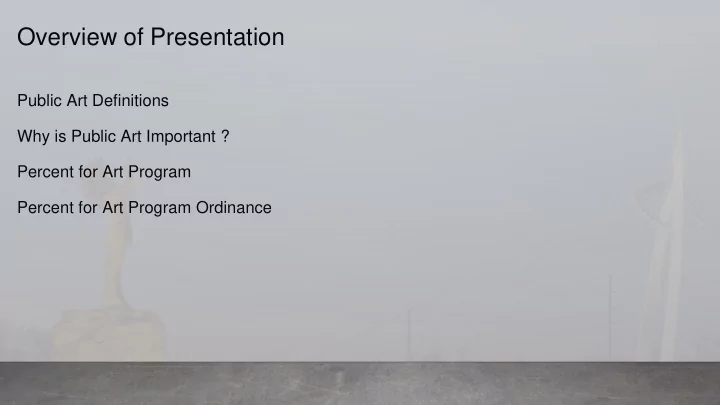

Overview of Presentation Public Art Definitions Why is Public Art Important ? Percent for Art Program Percent for Art Program Ordinance
Public Art Definitions Public art is often site-specific, meaning it is created in response to the place and community in which it resides. It often interprets the history of the place, its people, and perhaps addresses a social or environmental issue. Public art creates “Sense of Place and Destination.” I See What You Mean Lawrence Argent Denver, Colorado, Convention Center (Stand-Alone)
Why is Public Art Important ? Economic Growth and Sustainability By engaging in public art as a tool for growth and sustainability, communities can thrive economically. Seventy percent (70%) of Americans believe that the “arts improve the image and identity” of their community. Crown Fountain Jaume Plensa Millennium Park, Chicago, Illinois (Integrated)
Why is Public Art Important ? Attachment and Cultural Identity Public art directly influences how people see and connect with a place, providing access to aesthetics that support its identity and making residents feel appreciated and valued. Chroma Booster Matthew Geller El Paso, Texas (Integrated)
Why is Public Art Important ? Social Cohesion and Cultural Understanding Public art provides a visual mechanism for understanding other cultures and perspectives, reinforcing social connectivity with others. Lake Nessy Dixie Friend Gay Austin, Texas (Stand-Alone)
Why is Public Art Important ? Public Health and Belonging Public art addresses public health and personal illness by reducing stress, providing a sense of belonging, and addressing stigmas towards those with mental health issues. Nautical Swing Matthew Geller San Francisco, California (Stand-Alone)
Why is Public Art Important ? Artists as Contributors Providing a public art ecosystem supports artists and other creatives by validating them as important contributors to the community. Artists are highly entrepreneurial. They are 3.5 times more likely than the total U.S. work force to be self-employed. Chroma Booster (plaza level) Matthew Geller El Paso, Texas (Integrated)
Percent for Art Allocations by Peer Cities From Past Chamber of Commerce City to City Leadership Visits: Oklahoma City - 1% passed 2009 Austin - 2% passed 1985 Chattanooga - 1% passed 2009 Nashville - 1% passed 2000 Pittsburgh - 1% passed 1977 Raleigh/Durham - 1% passed 2016 Des Moines - 1.5% passed 2001 Boise - 1% passed 2010
Percent for Art Program • There are approximately 350 public art programs in the United States. • 97% of public art programs are housed within an umbrella organization such as a municipality or a local arts agency. • Nationally, 283 of the 350 public art programs are located within government agencies based within city, country or state government.
Percent for Art Program • Public art programs administer the development and management of public art in their communities. • In addition to creating new work, public art programs: • Maintain their public art collections • Develop educational programming • Create public art resources including printed materials and websites • Seek partnerships and opportunities with public and private organizations • Act as a source for public art information
Percent for Art Program The methods used to build a public art program include (1 of 2): • Commissioning stand-alone and integrated artwork • Purchasing existing artwork for permanent display and/or • Placing artists on design teams • Educational programming, artist services, conservation and maintenance of existing public art work are where public art programs require improvement.
Percent for Art Program The methods used to build a public art program include (2 of 2): • Government programs have the largest budgets and spend more money on art commissions and purchases than private non-profit programs. • However, private non-profit programs spend more money than government programs on conservation, artist outreach, and educational programming.
Public art is noted as slowing pedestrians down to enjoy their space and providing a positive impact on mood. High Trestle Pedestrian Bridge Schuck Britson RDG Dalhlquist Studio Des Moines, Iowa (Stand-Alone/Repurposed)
Public art fosters pride for neighborhoods and cities. Station North Arts and Entertainment District Jesse Unterhalter and Katey Truhn Baltimore, Maryland (Integrated)
Seventy-three percent of Americans agree that the arts “help me understand other cultures better.” Skydance Pedestrian Bridge Hans Butzer MKEC Engineering Oklahoma City, Oklahoma (Integrated)
Public art solves everyday problems with innovation and originality. Bike Rack Project multiple artists Nashville, Tennessee (Integrated and Stand-Alone)
Aesthetics is one of the top three characteristics why residents attach themselves to a community. Aloft Ed Carpenter Eisenhower Airport, Wichita (Integrated)
Public art is “Place - Making.” Keeper of the Plains Black Bear Bosin Confluence of Rivers, Wichita (Integrated)
Percent for Art Program Ordinance (1 of 3) • The committee believes a visionary and flexible Public Art Ordinance is what the City of Wichita needs. • The ordinance would establish the principle that artists should be involved from the earliest stages of conceptual planning, and continue through project design and implementation. It directs that sufficient resources should be committed to sustain and maintain an innovative public art and design program distinguished by its high quality.
Percent for Art Program Ordinance (2 of 3) • Establishes guidelines to identify eligible CIP projects that may be included in a Percent for Art program. • Establishes guidelines for when an Art Consultant and an Artist should be included in a project. • Authorizes the Design Council to determine and recommend which projects need to include an Art Consultant in addition to Design Team Artist.
Percent for Art Program Ordinance (3 of 3) • Establishes a mechanism to finance aesthetic components in public projects. • Establishes an “artist registry” and qualifications for public artists. • Establishes guidelines for the selection of art consultants and artists. • Addresses on-going and emergency maintenance costs. • Identifies the need for dedicated staff to provide administrative duties.
Questions?
Recommend
More recommend